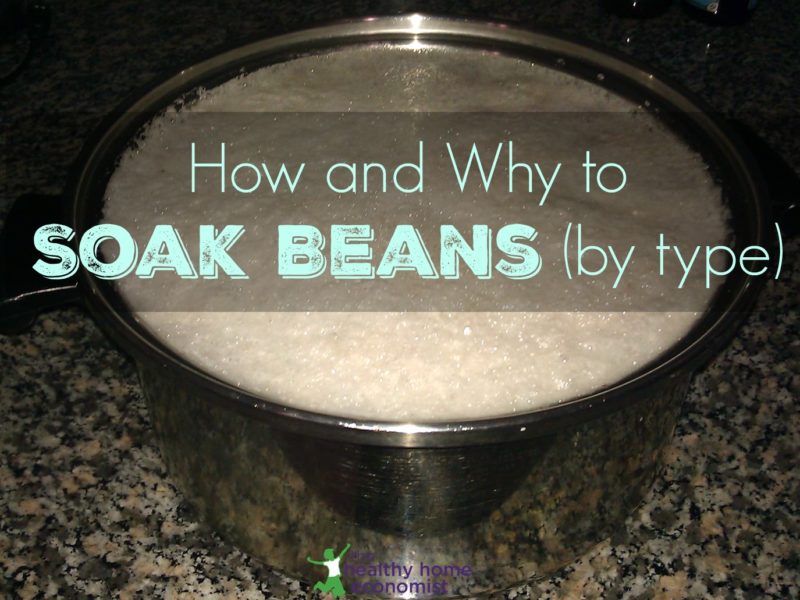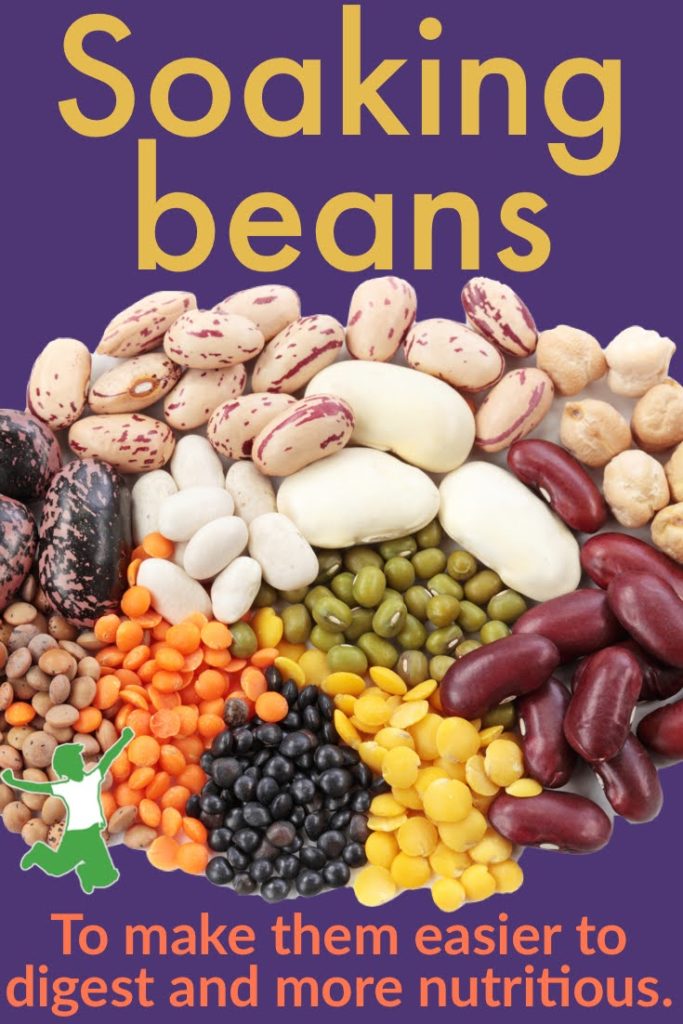Table of Contents[Hide][Show]
The simple overnight process of how to soak beans (by type) will help to eliminate gas and intestinal issues so you can enjoy eating these nutritious plant foods again!

I went on a bean soaking binge this past weekend, and the amount of scum that came to the top of the large pot of soaking kidney beans was so huge, I thought it deserved its own blog post. Soaking beans for many hours before cooking them produces a lot of scum which is course, is rinsed and drained away when the soaking is complete.
What is all that scum anyway? Anti-nutrients, that’s what! And those anti-nutrients such as phytic acid, lectins, and enzyme inhibitors are going to be in your gut causing you gas, heartburn, reflux, and whatever other digestive ills beset you when you eat something that isn’t particularly digestible unless you soak your beans before cooking them.
Traditional cultures took great care to prepare their legumes with a long soak before cooking to enhance digestibility and nutrient absorption.
I love Mexican food but really try to avoid Mexican restaurants for this reason .. they don’t soak their beans before cooking them!
After a meal at a Mexican restaurant, I will typically feel very bloated. Eating the same meal prepared at home where I soaked the beans properly before cooking results in no digestive upset whatsoever.
Take the Soaked Beans Challenge!
If you think unsoaked beans don’t cause you any trouble .. take this challenge. Soak beans next time before cooking and notice the difference in your stomach after eating.
You may think that the unsoaked beans don’t cause you any trouble, but you just may find that soaked beans are infinitely more filling and that you eat less and enjoy the meal more as a result!
Traditional peoples were very wise in the preparation of their foods. They not only selected nutritious foods but they prepared them for maximum digestibility and nutrition.
What good is eating nutritious legumes if the body is so whacked by the anti-nutrients that it can’t very easily extract and digest the nutrition?
So, the next time you make your beans, make sure you soak them first!
I soak large pots of various types of beans every month or so and then cook them – freezing for easy, quick meals when beans are required like homemade chili.
**If you absolutely do not have time to do this, at least buy pre-soaked legumes and beans packed in glass jars. Your digestion will thank you!
How To Prepare Beans by Soaking (video tutorial)
If you’ve never soaked beans before, it’s so easy. It’s a very similar process to soaking nuts. The method also mimics the wisdom of traditional societies that soaked seeds.
See this short video below that demonstrates the simple process.
Kidney shaped beans
For kidney shaped beans and dried/split peas, put a pinch of baking soda and enough water to cover in a large pot and soak uncovered for 12-24 hours. Drain, rinse and cook as usual.
Examples of kidney-shaped beans include:
- Red kidney beans
- White kidney beans (cannellini beans)
- Pinto beans
- Anasazi beans
- Black-eyed beans (black-eyed peas)
- Great Northern beans
- Lima beans
Non-kidney shaped beans (and other legumes)
For more oval-shaped beans and other legumes, soak for 12-24 hours in filtered water to cover plus 1 tablespoon of cider vinegar or lemon juice for every cup of dried beans/legumes used.
A homemade apple cider vinegar recipe or store-bought are both fine (make sure the ACV is packed in glass). Liquid whey from yogurt, kefir, or clabbered milk may also be used. Drain, rinse, and cook as usual.
Examples of non-kidney shaped beans include:
- Black beans (turtle beans)
- Navy beans
- Fava beans
- Adzuki beans
- Chickpeas
- Lentils
For maximum digestibility, it is best to rinse and refresh the filtered water and baking soda or the acidic medium once or twice during the soaking period. If you forget, no worries.
I try to always soak beans for the full 24 hours instead of just overnight. Sometimes if I get busy, I might even soak them 36 hours, but this is risky as they can get moldy sometimes if you go over 24 hours. Best to stay between 12-24 hours particularly during summer months.
How to Cook Beans After Soaking
After soaking, be sure to thoroughly drain and rinse the beans until all the scum is washed away. Then, complete the process by doing the following.
- Fill the pot of rinsed pre-soaked beans with fresh filtered water, bring to a boil, and skim away any additional foam that may come to the top at the start of the boil.
- Turn down the heat to a simmer, add 4 crushed garlic cloves, and cook until the beans are soft (about 4 hours).
- Drain beans and add to your favorite dish or let cool and freeze in large freezer bags for quick meals at a later date!
You won’t be needing over-the-counter gas meds after preparing beans the traditional way!
Should You Use the Soaking or Cooking Water?
Some alternative cooking circles advocate using the soaking or bean cooking water. Unfortunately, neither of these practices is traditional.
Using the cooked bean water or aquafaba is actually a dangerous practice. See the linked article for reasons to avoid this modern food especially during pregnancy!
Other Types of Legumes
This article plus video on soaking lentils provide additional information specifically for this legume. Because they are soaked exactly the same as all non-kidney shaped beans, it is helpful for visual learners.
Lentils were the favorite of nutritional pioneer Dr. Weston A. Price due to their very high potassium content.
Recipes Using Pre-soaked Beans and Legumes
Here are some recipes to try using soaked beans and other legumes to entice you!









The bicarbonate tip
Adding bicarbonate of soda, to both soaking and cooking liquids, makes the beans more tender although it does destroy part of the thiamine, making the amino acids less digestible. In other words, nutritional value is negatively affected.
Phytic Acid is GOOD FOR YOU!!!!!!!!!
“Emerging scientific evidences reveal that phytic acid has several positive effects on human health. The antioxidant and type 2 diabetes related enzyme inhibition properties of phytic acid extract prepared from raw and traditionally processed local grains and vegetables collected from Kenya were evaluated. Phytic acid content of raw grains and vegetables ranged between 2.81—3.01 and 0.29—3.23 g/100 g DM, respectively. The phytic acid extract from raw samples revealed 59%—89% of DPPH radical scavenging capacity, 27—3,526 mmol Fe(II)/g extract of reducing power, 20%—72% of α-amylase inhibition activity and 8%—91% of α-glucosidase inhibition activity. Cooking and roasting improved the antioxidant and health relevant functionality of phytic acid extracts obtained from Kenyan local vegetables and grains, respectively.”
http://thatpaleoguy.com/2011/10/06/phytic-acid-and-digestive-enzyme-blockade/
Read your own study!! It IS NOT GOOD FOR HUMAN CONSUMPTION
Phytic acid is not digestible to humans or non-ruminant animals, who lack the phytase enzyme (ruminant animals are able to digest it due to their gut bacteria producing enough phytase on their behalf). Due to this inability to digest phytic acid, we are unable to release the phosphorus for our own nutritional benefit. Furthermore, phytic acid can bind and render unabsorbable certain important minerals such as calcium, magnesium, iron, and zinc. In addition to this binding of minerals, phytic acid can also bind niacin (vitamin B3), potentially contributing to the deficiency disease pellagra.
This was taken from the website and study you directed us too!!
if you’re that worried about phytic acid you can do a fermentation soak where you save some of the soak water each time, lookt it up. fermentation will prep anything for digestion lol
Hello,
I started soaking beans last night for our missions group. I didn’t use filtered water and this morning there’s NO nasty film on top. It’s been over 12 hours. Do you think that the process won’t work since I used tap water? What should I do? Did i just pickle my beans??
@Shiva-
To whom was your post directed?
The author of the article or one of the commenters?
>>>I’d suggest to do research before posting opinions.<<>>>First of all, only soaked/sprouted seeds have enzyme inhibitors from the sprouting process and many lentils are poisonous when sprouted and cannot be eaten raw.<<<<
Perhaps you could clarify the contents by breaking the sentence up & expanding on the elements?
Could you also provide some authoritative cites for the claim:
"many lentils are poisonous when sprouted"
and "cannot be eaten raw" refers to…..sprouted or unsprouted lentils?
I’d suggest to do research before posting opinions.
First of all, only soaked/sprouted seeds have enzyme inhibitors from the sprouting process and many lentils are poisonous when sprouted and cannot be eaten raw. And nearly all seeds have small amounts of yeast just as many different fruits do on the outside of their skin. When you soak seeds with this yeast, it grows and produces what you call, “scum”.
Now I am not saying soaking is bad, it is good as you mentioned most of our ancestors did soak all grains and beans before cooking. But you should realize that lemon and apple cider vinegar doesn’t allow the seeds to sprout and through the sprouting process, nutrients become more bioavailable for the body. So when soaking any seed, you should use the purest of all water, water from a fresh spring or distiller water and mix a little Himalayan salt or black salt to add some minerals to the water, which the seeds will in return absorb and make them even more nutritious.
It’s funny to note that you know our ancestors were very knowledgable as they were, but you still don’t follow their wisdom of sprouting from using apple cider vinegar.
I hope you learned something, I’m for proper knowledge rather than opinions. It’s satanic to speak opinions as if they are facts because most of the time opinions aren’t right and therefore, it’s a lie. And it’s the lack of proper knowledge which leads the world to destruction (what is happening now).
I too am a little late to this thread but have just started soaking pinto beans (for about 24 hours) in baking soda and we are having more problems with bloating now than when I just buy canned, which is not preferable to us. Trying to figure out what I am doing wrong! I am not getting any scum during the soak or the cooking. I do not use the soak water or the cooking water… should I not cook the beans in a crock pot? Any suggestions???
To clarify, I am not using the water the beans were soaked in to cook the beans in nor am I using the water the beans are cooked in…
What do you do with split peas?
Are pinto beans to be soaked in baking soda, like kidney beans are? I heard any kidney shaped bean should be.